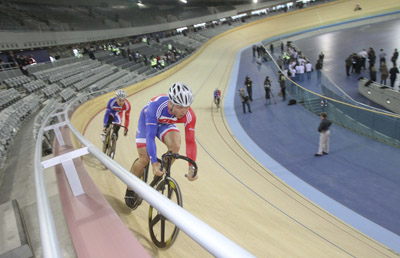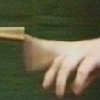
Teacher package: Classical mechanics
The Plus teacher packages are designed to give teachers (and students) easy access to Plus content on a particular subject area. Most Plus articles go far beyond the explicit maths taught at school, while still being accessible to someone doing GCSE and A level maths. They put classroom maths in context by explaining the bigger picture — they explore applications in the real world, find maths in unusual places, and delve into mathematical history and philosophy. We therefore hope that our teacher packages provide an ideal resource for students working on projects and teachers wanting to offer their students a deeper insight into the world of maths.
Classical mechanics

The London Velodrome's track is designed for maximum speed.
Whether it's the planets moving around the Sun or building the perfect cycling track, the key to many questions in our lives lies in classical mechanics. This teacher package brings together all our content on mechanics divided into two categories: Newtonian mechanics and fluid mechanics (which also comprises aerodynamics). You'll find articles containing explicit examples of the maths involved, some exploring the bigger picture without going into too much detail of the actual maths and others that use classical mechanics as a starting point and then look beyond. Have fun!
Don't forget about our sister site NRICH, which has hands-on problems, activities and articles on mechanics.
Newtonian mechanics
Explicit maths
Maths and climate change: The melting Arctic — The Arctic ice cap is melting fast and the consequences are grim. Mathematical modelling is key to predicting how much longer the ice will be around and assessing the impact of an ice-free Arctic on the rest of the planet.
101 uses of a quadratic equation — When you apply the laws of mechanics you often find yourself faced with a quadratic equation.

Natural frequencies and music — This article looks at the vibrations that can be harnessed by musical instrument makers.
Lagrange and the interplanetary superhighway — This article explains how chaos in the solar system is not only unavoidable but can also be beneficial, taking us on a journey that has been travelled by comets and spacecraft.
Outer space: What goes up must come down — How large are the forces acting on a gymnast swinging on the high bar?
Outer space: Rowing has its moments — If you look at the pattern of rowers in a racing four or eight rowing boat then you expect to find them positioned in a symmetrical fashion, alternately right-left, right-left as you go from one end of the boat to the other. However, the regularity of the rower's positions hides a significant asymmetry that affects the way the boat will move through the water.
Leaning into 2012 — The velodrome for London 2012 was not just built for elegance but also for maximal cycling performance. Find out how.
Modelling, step by step — Why can't human beings walk as fast as they run? And why do we prefer to break into a run rather than walk above a certain speed? Mathematics has the answers.

Making a racket: The science of tennis — Over recent decades new materials have made tennis rackets ever bigger, lighter and more powerful. So what kind of science goes into designing new rackets?
The bigger picture
The maths of gold medals: Four Olympic thoughts — It's not the winning, it's the taking part that counts. But, like it or not, what the media and governments focus on is the tally of gold medals. This article explores some of the maths of gold.
Making gold for 2012 — The changes engineers can make to athletes' equipment and clothes may only make a tiny difference to their performance, but once they're added up they can mean the difference between gold and silver. This article comes with a podcast.
The only way is up: Constructing the Heron Tower — Plus was lucky enough to speak to two engineers involved in building the Heron Tower in London and asked how maths was involved in the construction of such an impressive addition to the London skyline.
The right spin: How to fly a broken spacecraft — On the 25th of May 1997 a dramatic collision tore a hole into the space station Mir and sent it hurtling through space. As NASA astronaut Michael Foale tells Plus, the fate of Mir and its crew hinged on a classical set of equations.
Shaping our bones — We know that applying a force to a bone during its development can influence its growth and shape. But can we use our understanding of how developing bone reacts to mechanical forces to help people suffering from diseases that lead to bone deformities?
Beyond classical mechanics
Finding order in chaos — Newton's laws of motion may give you the impression that everything that happens in the physical world is entirely predictable. But is this really true?
Freedom and physics — And if nature is so predictable, then what about us? This article examines whether free will exists.
How does gravity work? — How does Einstein's theory of gravity differ from Newton's?
Outer space: A matter of gravity — Another look at our understanding of gravity from Newton to the cosmological constant.
Outer space: Two's company, three's a crowd — What happens when you introduce a third body into a system of two? A view from Newton and one from Einstein.
Schrödinger's equation — Last but not least in this section, here's something for the more advanced. Schrödinger's equation is the quantum mechanical analogue of Newton's second law of motion, which predicts such quantum weirdnesses as entanglement and superposition. It's a differential equation which in simple examples isn't all that hard to solve. This three part series of articles introduces the equation, looks at a simple example and tries to understand what it tells us about the real world.
Fluid mechanics
Explicit maths
Maths on a plane — Discover how maths helps solve the mysteries of flight and love.

Going with the flow — This article tells us what happens when two fluids of different densities meet, for example when volcanoes erupt and hot ash-laden air is poured out into the atmosphere.
Outer space: The answer to running in the wind — Runners and cyclists can tolerate heat and cold but the thing they dislike most is wind. They know it produces slower times. Can we show them why?
By the skin of their suits — Much has been made of the swimming events for London 2012 because the previous 2008 Beijing Olympics saw an unprecedented number of new world records, due to the use of controversial swimsuits. So how do these suits improve performance?
Outer space: Canoeing and kayaking — A simple question to ask about kayak races is whether having lots of paddlers helps or slows the boat down? The kayak with two paddlers has twice as many "engines" to power it but it also has twice as much weight to drag through the water. Which is the dominant factor?
If you can't bend it, model it — Learn about the aerodynamics of footballs and perfect your free kick.
The bigger picture
A fly walks around a football — What makes a perfect football? We find out that it's all down to the ball's surface.

Understanding turbulence — The study of turbulence is used to understand a range of phenomena from the simple squirting of a jet of water to the activity of the sun.
Supersonic Bloodhound — In 1997 Andy Green was the first to break the sound barrier in his car Thrust SSC. Now he and his team want to push things even further with a car called Bloodhound, designed to reach the dizzy heights of 1,000mph, about 1.3 times the speed of sound. This article explains how maths is used to build this car.
How maths can make you rich and famous — Understanding the behaviour of fluids and gases is one of the biggest open problems in maths.

Career interview: Aerodynamicist — Plus talks to Christine Hogan who studied aerodynamics planning to become a member of a Formula One team.
Making gold for 2012 — The changes engineers can make to athletes' equipment and clothes may only make a tiny difference to their performance, but once they're added up they can mean the difference between gold and silver. This article comes with a podcast.